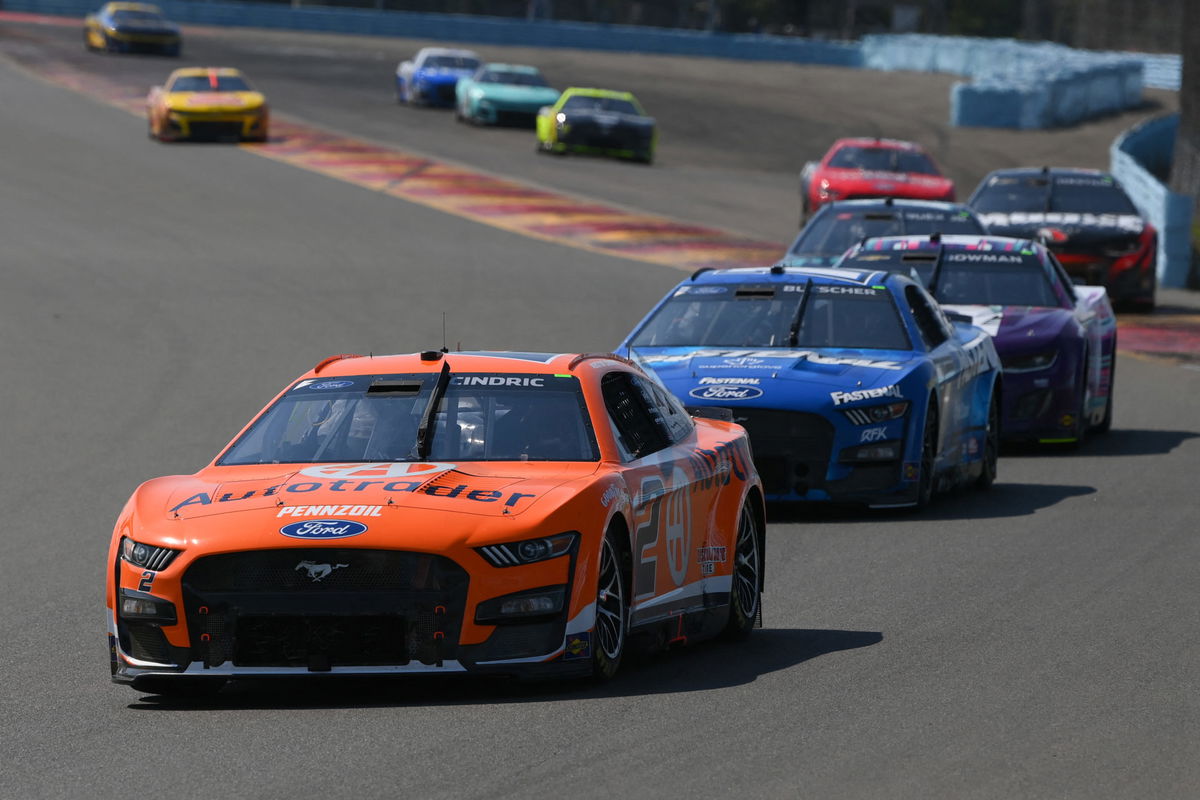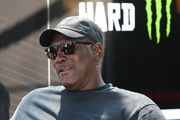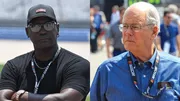
USA Today via Reuters
Aug 20, 2023; Watkins Glen, New York, USA; NASCAR Cup Series driver Austin Cindric (2) leads a group of cars during the Go Bowling at The Glen at Watkins Glen International. Mandatory Credit: Rich Barnes-USA TODAY Sports

USA Today via Reuters
Aug 20, 2023; Watkins Glen, New York, USA; NASCAR Cup Series driver Austin Cindric (2) leads a group of cars during the Go Bowling at The Glen at Watkins Glen International. Mandatory Credit: Rich Barnes-USA TODAY Sports
Do you know why the Talladega Superspeedway is nicknamed ‘The Big One’? It’s because the 2.66-mile tri-oval has a history of multi-car collisions on the racetrack. With NASCAR heading to Alabama for the second Round of 12 race, the stakes are higher than ever with playoff drivers hoping to secure an automatic berth into the next round. Next-Gen cars run at an average of 180 mph at the ‘Dega’. This means that the limited 20-minute practice session might not be enough for racers going into the 2024 YellaWood 500.
Watch What’s Trending Now!
The decision to reduce practice sessions was a part of NASCAR’s initiative to cut costs during the COVID-19 pandemic. Whether the sanctioning body succeeded in its attempt remains up for debate. However, the decision has invoked mixed reactions from the motorsports community.
ADVERTISEMENT
Teams will be venturing into the unknown at Talladega
Practice sessions in NASCAR have become virtually nonexistent. The sport went from having over 12 hours of practice in the early 1980s to less than half an hour, followed by a qualifying session. What led to this drastic change? Reducing the practice time allowed to streamline the car inspection process. This change was brought about so that it wouldn’t have to be done before the races.
The organization also limited the number of changes that could be made to the cars. This reduced the need for mechanics as before. The decision to do so was NASCAR’s attempt at lowering travel and personnel costs for its teams.
With an air deflector potentially being added on the right side of the windshield of the Next-Gen cars, plenty of uncertainties have come up that teams and drivers will have to deal with at Talladega Superspeedway. Speaking on the Door Bumper Clear podcast, NASCAR Insider Brett Griffin highlighted the unknowns by saying, “Crew chiefs and engineers, they will be in full-blown panic right mode right now. Because it’s not been tested, it’s not been run, we don’t know what it’s going to do, and guess what else we’re not doing when we get there? We’re not practicing!”
ADVERTISEMENT

USA Today via Reuters
Apr 23, 2023; Talladega, Alabama, USA; A multi-car wreck begins from contact between NASCAR Cup Series driver Bubba Wallace (23) and NASCAR Cup Series driver Ryan Blaney (12) on the final lap at Talladega Superspeedway. Mandatory Credit: Vasha Hunt-USA TODAY Sports
Every time teams visit a track, particularly Superspeedways, they use data from previous races to devise a race strategy. However, if NASCAR makes changes to Next-Gen car ahead of the second Round of 12 races, it will add a new variable that could severely change the way the race plays out. By allowing extended practice sessions, teams can understand how the changes made to the car affect its performance, helping them plan for a high-stakes playoff race accordingly.
ADVERTISEMENT
For many NASCAR teams, limiting practice sessions has not reduced costs. They have invested heavily in simulation models to make up for the lack of real-world practice. The costs equal if not exceeding what they incurred before the pandemic. With the competition in the sport being cutthroat, all teams are looking to get any advantage they can get their hands on. Not only did NASCAR take away something that fans would enjoy, they have replaced it with a more expensive alternative. But did NASCAR introduce the measure to bring about equality to the track?
Top Stories
What Settlement Agreement Have Michael Jordan & NASCAR Reached? Everything to Know From Evergreen Charters to Payout

NASCAR Flexes Authority With Drastic ‘Sign or Sell’ Charter Clause Hours After $365M Lawsuit Settlement

Michael Jordan Makes 8-Word Statement After Forcing NASCAR to Lawsuit Settlement

Michael Jordan Brings NASCAR to Its Knees as Jim France’s Courtroom Collapse Triggers Settlement

Jordan Fish Pens Heartfelt Message for Fiancé Denny Hamlin After Dramatic Courtroom Settlement With NASCAR

Do practice sessions benefit the bigger NASCAR teams?
There has been plenty of debate within the NASCAR community about the pros and cons of practice sessions. While some believe that it helps drivers get a feel of the track while building anticipation among fans ahead of the race, others think that it creates a sense of predictability that the sport doesn’t need. The likes of Hendrick Motorsports and Joe Gibbs Racing have resources at their disposal that some of the smaller teams can’t afford. This means that heading into a race weekend blind could potentially level the playing field to some extent.
ADVERTISEMENT
Sharing his thoughts about the matter, Front Row Motorsports driver Michael McDowell said, “I wish we didn’t have practice at all. I know there’s guys that would like to have practice and I understand why they would, but selfishly, I think any time that they give us more time to practice, the bigger teams do a better job of maximizing their car potential and setup.”
This begs the question, how much practice is too much? With drivers competing in the same cars every week, do teams need more time to make adjustments before the race? In some instances, it would be necessary. Especially when a new track comes into the picture or a Next-Gen car has to deal with varied changes. However, it’s easy to understand why some of the smaller teams wouldn’t want to give an undue advantage to the race favorites. The unpredictability of NASCAR races is what makes the sport entertaining for fans.
ADVERTISEMENT
ADVERTISEMENT
ADVERTISEMENT
ADVERTISEMENT

